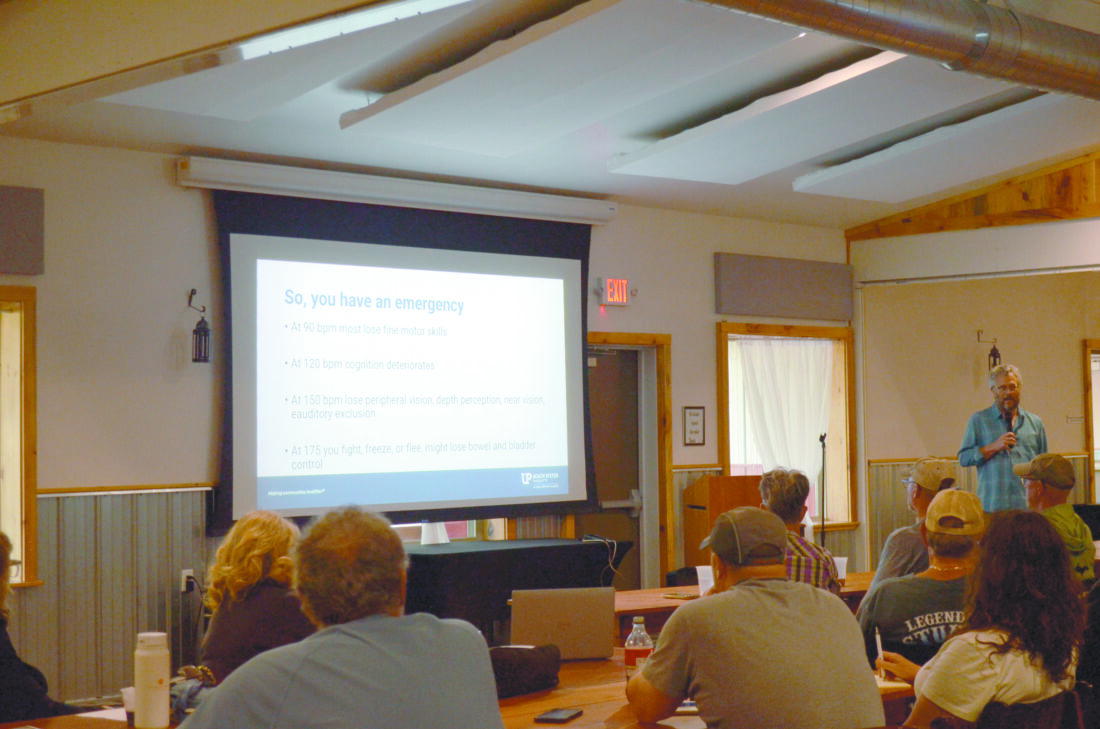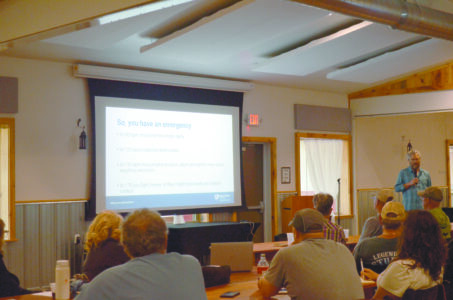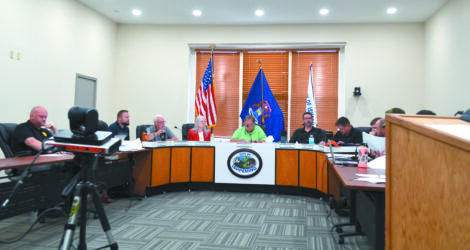Wilderness rescue response tips for the average person

Dr. Nathan Esplin presented on wilderness rescue for the layperson at the Up North Lodge’s Conference Center on Tuesday evening. The event was the first of Forsyth Forward’s “Know Our Wild” lecture series. (Journal photo by Abby LaForest)
GWINN — To kick off their “Know Our Wild” lecture series, Forsyth Forward brought in Dr. Nathan Esplin to talk about wilderness rescue for the layperson.
Esplin, a neurosurgeon with UPHS-Marquette, has a background in being a certified Wilderness First Responder. He’s taught for the Red Cross, the American Camp Association and has trained guides in his nine years of rural and backcountry EMS/SAR experience.
For someone without first responder training who encounters an emergency, Esplin said that the first step in responding is evaluating your own vitals and making sure that you’re in a position to help.
“The first thing to do is approach (the emergency) with the right mindset. The worst thing you can do is turn into another victim. You (could) get out of your head, hurt yourself, get somebody else hurt, so the first thing you do is calm down,” Esplin said. “The definition of stress is the difference between what you think the situation needs and what you can bring to the table…fix what you can fix and accept that any help you’re going to give is going to help.”
He explained that a key to calming down is making sure your heart rate doesn’t get too high, because higher heart rates make it difficult to help in an emergency, and it’s common for most people to lose fine motor skills when their heart rate is higher than 90 beats per minute.
Considering your own safety is the next step to take, which involves evaluating environmental hazards such as vehicles on the road, dangers that may be present in the terrain or weather of the area, or if any animals are nearby that could be a problem.
“Think about their position. If they have a…femur fracture and their ankle is by their ear, can you leave them like that? Can you move them? Is it safe to move them? And then again, consider the environment. Here when (I’m out hiking) it’s 75 degrees – not particularly hot – but (an emergency victim is) in shape, let’s say they’re a little bit older, they can be hypothermic faster than you think, just from the environment if they’re not doing well, especially if they’ve been there for a little bit. I’ve treated horrendous cases of hypothermia in 50 degrees because the person just otherwise wasn’t doing well, they lost some blood, so think about whether or not they’re warming up. Those little Mylar (emergency) blankets save lives,” Esplin explained.
Communicating that you’ve encountered an emergency is also important, such as knowing whether or not you have cell phone service or, if necessary, if there’s space to land a rescue helicopter nearby. When contacting 9-1-1 dispatchers, knowing where you are and being able to describe your location to a non-local is extremely helpful. Esplin explained that ideally, dispatchers will be able to see your location if you can’t fully describe it, and that they have very specific, effective protocols that they follow when responding to emergencies. If you have to call 9-1-1 for a wilderness emergency, you should be prepared to answer three questions: your location, your contact information, and details of what is happening.
Dr. Esplin also went over basic procedures to address physical examinations, bleeding, fractures, joints and body part stabilization. He also made some recommendations for a relatively inexpensive wilderness response kit that can be kept in a place like a backpack or an ATV. A decently prepared wilderness response kit would ideally include the following items:
• A CPR mask
• Gloves
• ACE bandages
• Gauze
• A moldable splint
• A tourniquet
• A head lamp
• A sharpie with duct tape around it
• A Mylar blanket, wool blanket or sleeping bag
While the lecture wasn’t a comprehensive lecture on everything to know about being a Wilderness First Responder, Dr. Esplin recommended that people who are interested take the course do so, and that the tips he offered are small ways to help increase a person’s odds of survival if you encounter a wilderness scenario that requires medical attention.
“What we can try to do it give you some tips, little things you can carry, little things that might be handy if you do come across something, little things that can cut back on the amount of stress (and) the amount of thinking you have to do to improve somebody’s chance of survival,” said Esplin.
Wilderness First Responder and First Aid courses are offered through the National Outdoor Leadership School at nols.edu/courses/wm/wilderness-first-responder-wfr, Wilderness Medical Associates International at wildmed.com/courses/standard/5-day-wilderness-first-responder, and the American Red Cross at redcross.org/take-a-class/cpr/wilderness-sports. More information can be found on each organization’s respective websites.
Forsyth Forward will continue with the “Know Our Wild” lecture series into next year. The full schedule of topics can be found online at exploreourwild.com/learn. More information about Forsyth Forward can also be found on their website at forsythforward.org.
Abby LaForest can be reached at 906-228-2500, ext. 548. Her email address is alaforest@miningjournal.net.





